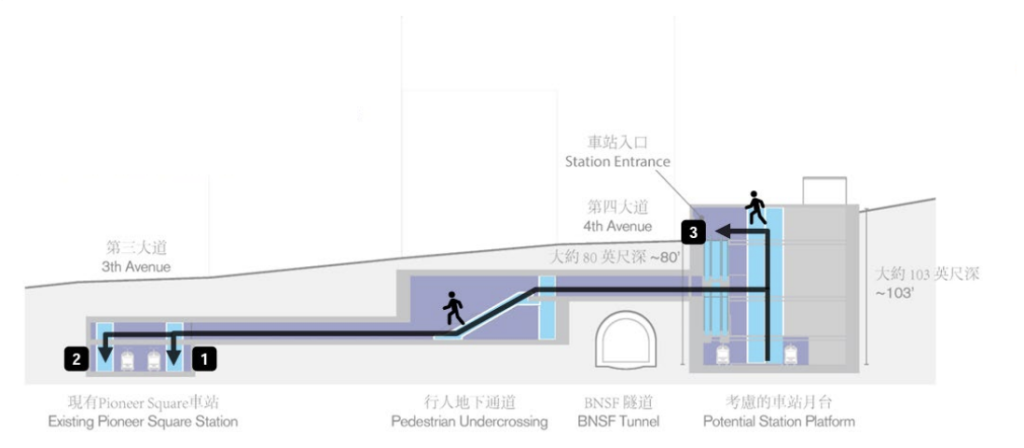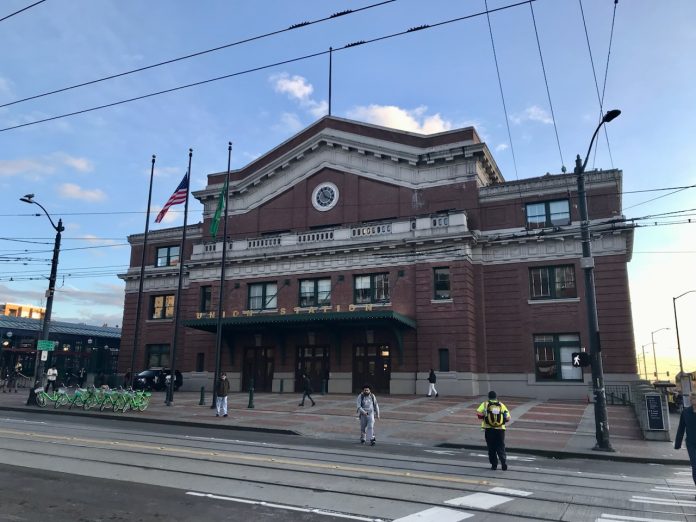
Sound Transit Expansion Committee votes today with momentum building for unvetted North of CID station concept.
Riders across the region are set to see longer travel times for common transfers if a new Link station is not centered on the Union Station Hub at S Jackson Street. That affects many different trip pairings for riders coming from the Rainier Valley, South King County, Pierce County, parts of Snohomish County, Eastside, and even from South Lake Union, Uptown, and Ballard.
As Link expands to Bellevue, then West Seattle and Ballard, the current straight line followed by light rail will be divided. Trains from Ballard will go through a new downtown tunnel to connect to the existing line at SODO and continue to SeaTac/Airport and Tacoma Dome as Link 1 Line. Trains from Bellevue and Redmond will enter the city at the existing Chinatown-International District (CID) station and continue through the existing downtown tunnel all the way north to Lynnwood as Link 2 Line. Trains from Everett and the north will share that track and transit tunnel, then branch at SODO to West Seattle as Link 3 Line. Any trip switching between tunnels would best occur at Westlake or Union Station. Removing the Union Station option and shifting the vital transfer deep into downtown results in significant ridership-impacting delay.
Debate has been swirling around such brand new station concepts at the junction of 4th Avenue and James Street (North of CID), a random no-man’s-land station near to I-90 (South of CID), and a combo of those two for the new 1 Line. Some Sound Transit boardmembers have already telegraphed that they are prepared to take that step, though those concepts will decrease ridership according to initial Sound Transit projections and leave thousands of daily riders with slower, more inconvenient trips.
Sound Transit staff have not fully vetted these new concepts and their analysis in the transfer experience scenarios has so been incomplete.




North of CID-to-Pioneer Square transfers are long and backward
Project development staff have proposed a nine-story-deep station at 4th Avenue/James Street that connects to the existing Pioneer Square Station. Sound Transit has touted transfer times at three minutes. However, the transfer time is much closer to four or five minutes and potentially considerably more. That’s because circulation within the stations must be fully accounted for, not just the passageway and elevator travel time.
This new station is complex because it requires building an underground passageway over the BNSF rail tunnel running under 4th Avenue — a big construction challenge — and descending quickly down the hill to reach the existing north end mezzanine at Pioneer Square Station. The passageway would also involve use of an escalator to bring riders to the lower level of the existing station.
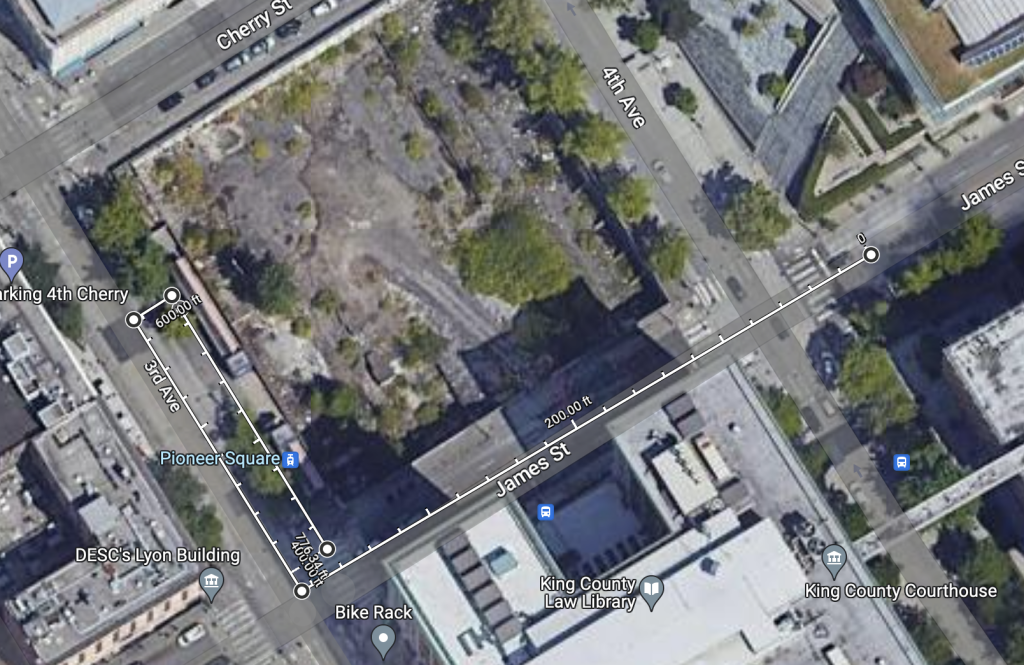
While the distance of the passageway would be about the 380 linear feet and roughly 90-second, according to the agency, there’s a lot more to it. Circulating the Pioneer Square Station mezzanine, climbing or descending stairs or escalators, and walking respective station platforms. The addition of those aspects would add more than 370 feet of distance or 80 seconds of walking, and then on top of this is the escalator and elevator piece which is certainly variable. A big risk here is the specter of escalator and elevator delays either from call times, congestion, or outages that increase transfer times. (Only two principal escalators are proposed from the north lower mezzanine to the upper mezzanine and one elevator at the North of CID Station.)
Some trip pairs may require riders to retrace their steps to complete their transfer. In the North of CID alternatives, such out-of-direction travel is a common issue with riders wanting to transfer to or from the 2 Line and 1 Line via Pioneer Square. This affects every rider wanting to travel between the Eastside and Rainier Valley or points south. Going from Bellevue, riders would have to pass north of International District/Chinatown Station to Pioneer Square Station and then transfer to the other Pioneer Square Station at 4th Avenue/James Street before waiting for their train to head south. This all adds to about 10 minutes more trip time than a direct transfer at a Union Station Hub.
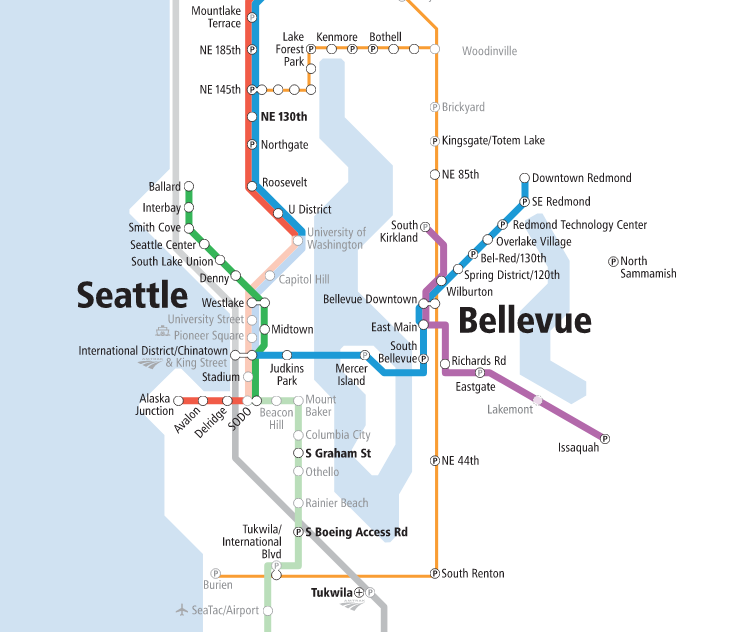
Though not out-of direction, a similar issue exists for Sounder riders headed to South Lake Union. They would have to catch the 2 or 3 Lines at International District/Chinatown Station and then transfer stations at Pioneer Square Station or Westlake Station to the 1 Line. This adds a three-minute wait time penalty at peak hours plus at least six minutes of station transfer and travel time penalties, which ultimately piles up to almost 10 minutes of additional trip times.
SODO Station transfers are flummoxing.
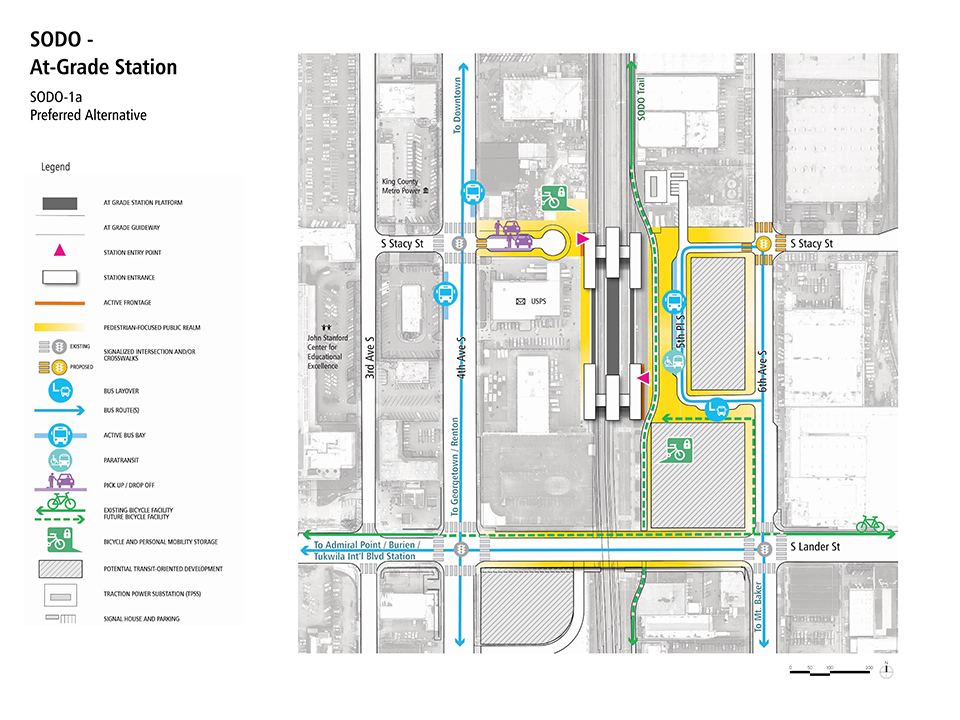
The same problems are replicated at other alternative stations that project development staff have modeled. In some scenarios, staff expect riders to take a three-seat ride in order to make a complete transfer. Riders going to Bellevue from Beacon Hill or the airport would be encouraged to transfer from the 1 Line at SODO Station, catch the 3 Line (Alaska Junction-Everett) northbound, and then transfer at International District/Chinatown Station to the eastbound 2 Line (Lynnwood-Redmond). Mathematically, this transfer option may be superior to some alternatives like going all the way Westlake Station if no new station is built at Union Station or 4th Avenue/James Street, but it’s certainly not the obvious one and introduces potential hiccups — like if 2 Line service is suspended — that could leave riders stranded.
The SODO Station plans envision a double station complex in the middle of the SODO Busway. The 1 Line would take over the existing tracks and a new set of tracks would be constructed on the west side of the busway for the 3 Line. In the process, Sound Transit would build entirely new station facilities.
While there would be a wide middle platform to serve northbound 3 Line trains to Everett and southbound 1 Line trains to Rainier Valley and other points south, it wouldn’t provide many logical cross-platform transfers beyond trips originating in West Seattle and then heading south or southeast. Instead, in the Beacon Hill/airport-Bellevue example, riders would have to make transfers by way of newly built pedestrian bridges and stairs/escalators at either ends of the platforms. That would require about a 400-foot walking distance or a 1 minute and 30 seconds walk time. Adding in an extra connection, in this example, also imposes at least another six-minute transfer time penalty (outside peak hours, it could be higher) due to the extra train. Compared to a single Union Station Hub transfer, this alternative would introduce at least a 7.5-minute transfer time penalty but Sound Transit lowballs this with a five-minute transfer penalty.
Trip pairs suffer without a Union Station Hub.
A lot of trip combinations will be worse off if the Union Station Hub and Chinatown are abandoned, and that should be immensely concerning to all Sound Transit boardmembers regardless of subarea.
Comparison of Trip Pairs and Transfer Penalities
| North of CID and North and South of CID Scenarios | ||
| Trip Pair | Transfer Options | Added Time Penalties |
| Beacon Hill/Rainier Valley – Chinatown/King Street Station | Option 1: SODO Option 2: Pioneer Square | Option 1: ≥7.5mins Option 2: ≥8mins |
| Pierce County/South King County (via Sounder) – South Lake Union | Option 1: International District/Chinatown and Pioneer Square Option 2: International District/Chinatown and Westlake | Option 1: ≥ 9.5mins Option 2: ≥ 9.5mins |
| Chinatown – Airport | Option 1: SODO Option 2: Pioneer Square | Option 1: ≥ 7.5mins Option 2: ≥ 8mins |
| Ballard/Uptown – Chinatown/King Street Station | Option 1: Pioneer Square Option 2: Westlake | Option 1: ≥ 4 mins Option 2: ≥ 6mins |
| Edmonds (via Sounder) – South Lake Union | Option 1: International District/Chinatown and Westlake Option 2: International District/Chinatown and Pioneer Square | Option 1: ≥ 9.5mins Option 2: ≥ 9.5mins |
| Bellevue/Redmond – Airport/Rainier Valley | Option 1: International District/Chinatown and SODO Option 2: International District/Chinatown and Pioneer Square | Option 1: ≥ 7mins Option 2: ≥ 10mins |
| South of CID Scenarios | ||
| Beacon Hill/Rainier Valley – Chinatown/King Street Station | Option 1: SODO | Option 1: ≥7.5mins |
| Pierce County/South King County (via Sounder) – South Lake Union | Option 1: International District/Chinatown and Westlake | Option 1: ≥ 9.5mins |
| Chinatown – Airport | Option 1: SODO | Option 1: ≥ 7.5mins |
| Ballard/Uptown – Chinatown/King Street Station | Option 1: Westlake | Option 1: ≥ 6mins |
| Edmonds (via Sounder) – South Lake Union | Option 1: International District/Chinatown and Westlake | Option 1: ≥ 9.5mins |
| Bellevue/Redmond – Airport/Rainier Valley | Option 1: International District/Chinatown and SODO Option 2: Westlake | Option 1: ≥ 7mins Option 2: ≥ 10mins |
All of these extra transfers and time penalties sting. They would make our region’s transit network more of a barrier to people who are disabled, elderly, toting children, or just carrying larger luggage and goods.
But the region may also be on the precipice of condemning historically disadvantaged communities to worse transit service than they have today if Sound Transit boardmembers don’t scuttle the North and South of CID alternatives. Rainier Valley riders would face at least an extra eight minutes of travel time to Chinatown and Union Station Hub, a common trip that many already make today. That same time penalty applies to Chinatown riders who similarly want to get to points south like the Rainier Valley or airport. This is inequitable and further disadvantages these communities in the process.
Stride is not a supplement for Link and future Link extensions should have relevance.
Project development staff presented peculiar comparatives last month that tried to compare Stride S1 Line bus rapid transit times between the airport and Bellevue as a better alternative to Link. That comparison is flawed because Stride is at the mercy of highway performance. Collisions and congestion are common on I-405 and routinely bring the highway to a crawl and standstill, even in HOV and HOT lanes. An S1 Line trip to the airport would still require a Link transfer at Tukwila International Boulevard Station from the SR 518 freeway median.
Link riders east or south of Bellevue Transit Center choosing Stride would experience another forced transfer and added time penalties. And frequencies on the S1 Line are expected to be significantly lower than Link lines. Ultimately, the lower estimated travel time that Sound Transit produced is a best case scenario at peak times and not a reliable comparative.
Additionally, it’s important to think of the bigger system being built. The Link 4 Line (Issaquah-South Kirkland) is indeed further out on the horizon, but forced transfer combos and time penalties become even more unwieldy without a complete Union Station Hub connection. Some trips could require a four-seat ride (e.g., Issaquah to the airport or Rainier Valley via Bellevue-Union Station Hub-SODO) within the Link system. That’s just wild and clearly not a rational choice that riders would want to make.
Now’s the time to get this right.
After nearly seven years of planning processes, it’s time to stop sending the West Seattle and Ballard Link Extensions in circles on station locations. The Sound Transit Board of Directors should settle this matter once and for all by rejecting the “further studies” alternatives that aren’t centered on the Union Station Hub. The hub is the heart of the region’s transit system and cannot be skipped over by a multi-century transit investment. Voters passed Sound Transit 3 because they believed it would make their regional transit experience better off, not worse. The Union Station Hub must be directly served by the 1 Line in any Sound Transit 3 expansion scenario — the numbers just bear that out.
The Sound Transit System Expansion Committee will meet today (March 9th) at 1pm to vote on the Ballard Link alternatives and hear from the public. You can provide feedback via email at meetingcomments@soundtransit.org or verbally at the meeting in-person or online. To speak in-person, you must sign up and can do so up to 30 minutes before the meeting. To speak virtually online, you must sign up at least five minutes before the meeting. Note that virtual signup opens at 8:00am. The full Sound Transit Board is scheduled to vote on a preferred alternative for the CID and the remainder of Ballard Link on March 23rd.
Stephen is a professional urban planner in Puget Sound with a passion for sustainable, livable, and diverse cities. He is especially interested in how policies, regulations, and programs can promote positive outcomes for communities. With stints in great cities like Bellingham and Cork, Stephen currently lives in Seattle. He primarily covers land use and transportation issues and has been with The Urbanist since 2014.

